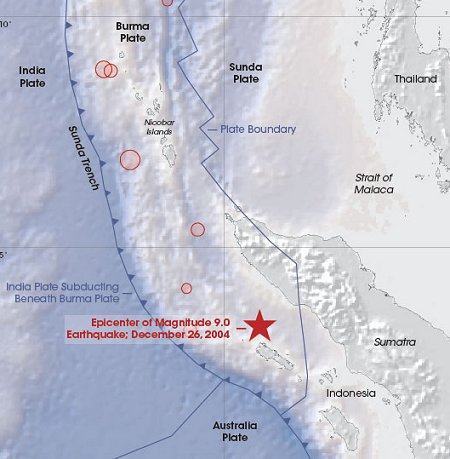|
The Dec 26th 2004 Indonesian megathrust earthquake quickened
Earth's rotation and changed our planet's shape.
by Dr Tony Phillips
NASA scientists studying the Indonesian
earthquake of Dec. 26, 2004, have calculated that it slightly changed
our planet's shape, shaved almost 3 microseconds from the length
of the day, and shifted the North Pole by centimeters.
Dr. Benjamin Fong Chao of NASA's Goddard Space
Flight Center and Dr. Richard Gross of NASA's Jet Propulsion Laboratory
said all earthquakes have some effect on Earth's rotation. It's
just that the effects are, usually, barely noticeable.
This one was not usual: The devastating megathrust
earthquake registered nine on the new "moment" scale (modified Richter
scale), making it the fourth largest 'quake in one hundred years.

more
Geography
of the Dec. 26th Indonesian earthquake
|
Chao and Gross routinely calculate earthquakes'
effects on Earth's shape and rotation. They also study changes in
polar motion--that is, the shifting of the North Pole.
According to their latest calculations, the Dec.
26th earthquake shifted Earth's "mean North Pole" by about 2.5 centimeters
(1 inch) in the direction of 145 degrees east longitude, more or
less toward Guam in the Pacific Ocean. This shift is continuing
a long-term seismic trend identified in previous studies.
The quake also affected Earth's shape. Chao and
Gross calculated that Earth's oblateness (flattening on the top
and bulging at the equator) decreased by a small amount--about one
part in 10 billion. This continues the trend of earthquakes making
Earth less oblate. Less oblate means more round.
They also found the earthquake decreased the length
of the day by 2.68 microseconds. (A microsecond is one millionth
of a second.) In other words, Earth spins a little faster than it
did before. This change in spin is related to the change in oblateness.
It's like a spinning skater drawing arms closer to the body resulting
in a faster spin.
None of these changes have yet been
measured - only calculated. But Chao and Gross hope to detect the
changes when Earth rotation data from ground based and space-borne
sensors are reviewed.
|
